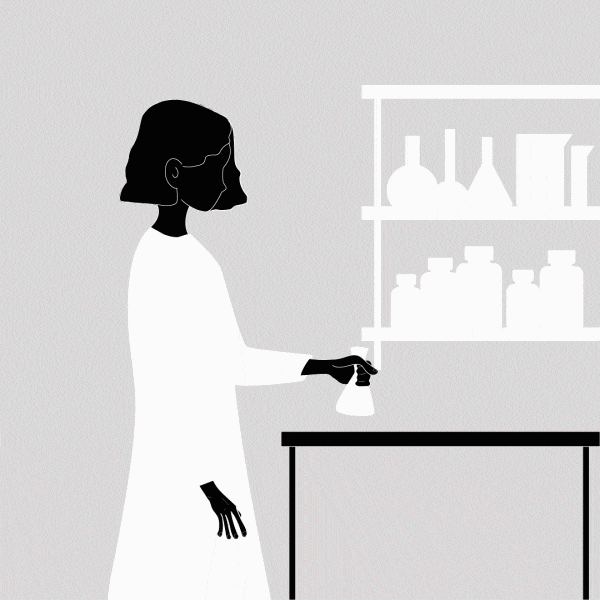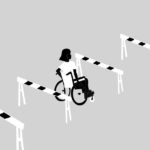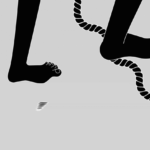GIRLS IN SCIENCE
I like to think of people’s ideas on the field I study as amazing. I am talking about comments that defeat the ardent desire for discoveries and research and those that see only the “educational” side of these directions. Words such as girls are not allowed to cross the door of the house and the diary of a teacher who is someone’s mother and good wife, but not a scientist who works alongside colleagues in the laboratory.

Illustration: Argjira Kukaj
In science, facts knit the truth, but it is nature that directs, or society that decides who studies what …
Now, as you read these words, imagine someone possessing courage, curiosity, and perseverance. Think of someone who will explore nature and solve essential space equations. Think of the people who discovered the structure of DNA, laid the foundation for WiFi and GPS, and who studied the thread of the universe.
How would you describe their zeal? Who and how did you imagine it.
Were the white-clad with a passion for the mysterious, hardworking and with days full of complex experiments. They were geniuses in their field, they were all women: Rosalind Franklin (‘The Secret DNA Woman’), Hedy Lamarr (20th Century Star) and Laura Mirsini Houghton (Albanian-American Cosmologist). These were the controversial women of the time. They were the ones who entered and penetrated the world of science (masculine until then) and who inspired the scientists of the present.
The first scientist ever considered to be Agamede (in the time of Ancient Egypt) and that in the field of medicine – as a large part of women until the twentieth century – but Marie Curie remains representative of the challenges of women and girls in the exact sciences. In fact, it would take her decades to get rid of the stigma of “just a male aide” – also a scientist.
Meanwhile, in Kosovo, according to statistics (the latest such detailed) of Education for 2017/2018 from the Kosovo Agency of Statistics, there is a significantly larger number of girls than boys, studying at the Faculty of Mathematical and Natural Sciences, respectively 375 girls and 182 boys. From these numbers it could easily be concluded that Kosovo can have great potential to be represented in science by girls and women, right?
However, from what is published on the official website of the Faculty of Mathematical and Natural Sciences, regarding the academic staff, it can be seen that: 16.67% in the Department of Physics, 19.23% in the Department of Biology and 33.3% in the Department of Chemistry are women professors, while for the Department of Mathematics and Geography the name of any women professor has not been published.
Lorik, my colleague, would say: “It is more than true that most of the professors in my faculty are male, if I am asked if I am satisfied with this fact, my answer would leave much to be desired”.
Representing women would be an incentive for aspirations to grow and would be a step towards breaking that patriarchy within. So are there really more welcoming directions for girls and women?
The reports we have available may not reflect the true motives of the studies or the expected results thereafter.
In fact, there is a lack of data on the specific number of girls and boys studying in colleges, and even more so on their specific number within departments, but also on potential jobs after graduation (in the field of physics) there isn’t any.
For me it was precisely the derivation of functions, the formulation of equations and the joy of particular solutions that filled me the most during these semesters. Another colleague shared the same opinion. “Upon completion of my studies, I hope to have developed critical thinking and problem-solving skills,” says Jeta.
Statements such as: “I started studying physics because I like numbers and nature” by Albulena or as “My first dream was to do scientific research, which Kosovo is in dire need of and is in short supply”, by Arbrita, another colleague, Altini “Dreams have been and continue to be great including the title Dr.sc, but if one day I can not achieve them, it would have been satisfying to serve the country as a professor”, are not uncommon in the Department of Physics.
Therefore, I like to think of people’s ideas on the field I study as amazing. However there are also such comments that many young girls and women experience. I am talking about comments that defeat the girls’ ardent desires for discovery and research. Comments that see only the engaging side of women in the education system. Words such as girls are not allowed to cross the door of the house and the diary of a teacher who is someone’s mother and good wife, but not a scientist who works alongside colleagues in the laboratory.
Beyond the challenge of a non-supportive mindset and environment for women, statistics on the number of students completing their studies at the University of Prishtina employed, the sectors and jobs they are involved in are also completely deficient, making it difficult to see what the future may bring.
Therefore, we often discuss what we can see or do with such a degree; whether we could work in the Kosovo Metrology Agency or the Kosovo Hydrometeorological Institute, whether we would have the heart to look beyond that, or whether our eyes would be directly on education.
… And as always only hope…
Although in general education and science are two intertwined fields, such a dominant opinion in society really underestimates the work of each teacher for the foundations they build and the whole field of science which still remains a word in the drawers of dreams.
As Arbrita would remind me of Walter Levin’s famous saying, “Teachers who make physics boring are criminals,” and almost all of them, see all party members who see science only as education, the abyss of girls’ aspirations. These words are ideas that shape the reality of many girls, unfortunately…
About the author: Lyra Hoxha, 18 years old from Prishtina, is a student in the Department of Physics at the University of Prishtina.
This grant is supported by the Balkan Trust for Democracy, a project of the German Marshall Fund of the United States


